BMP6004 - Analysing Organisational Learning for Improved Performance
VerifiedAdded on 2023/06/18
|11
|3204
|55
Report
AI Summary
This report critically evaluates the role of organisational learning in improving organisational performance, using theories and models. It explains organisational learning as the creation, retention, and transfer of knowledge within a company, highlighting its importance in adapting to changing business environments. The report also discusses the concept of a learning organisation, emphasising continuous learning and adaptation. An analysis of organisational performance is provided, linking it to employee satisfaction, productivity, and the ability to fit within the external environment. The Peter Senge model is used to analyse how learning factors improve performance. The report concludes by reiterating the significance of organisational learning in achieving a competitive advantage and fostering innovation.
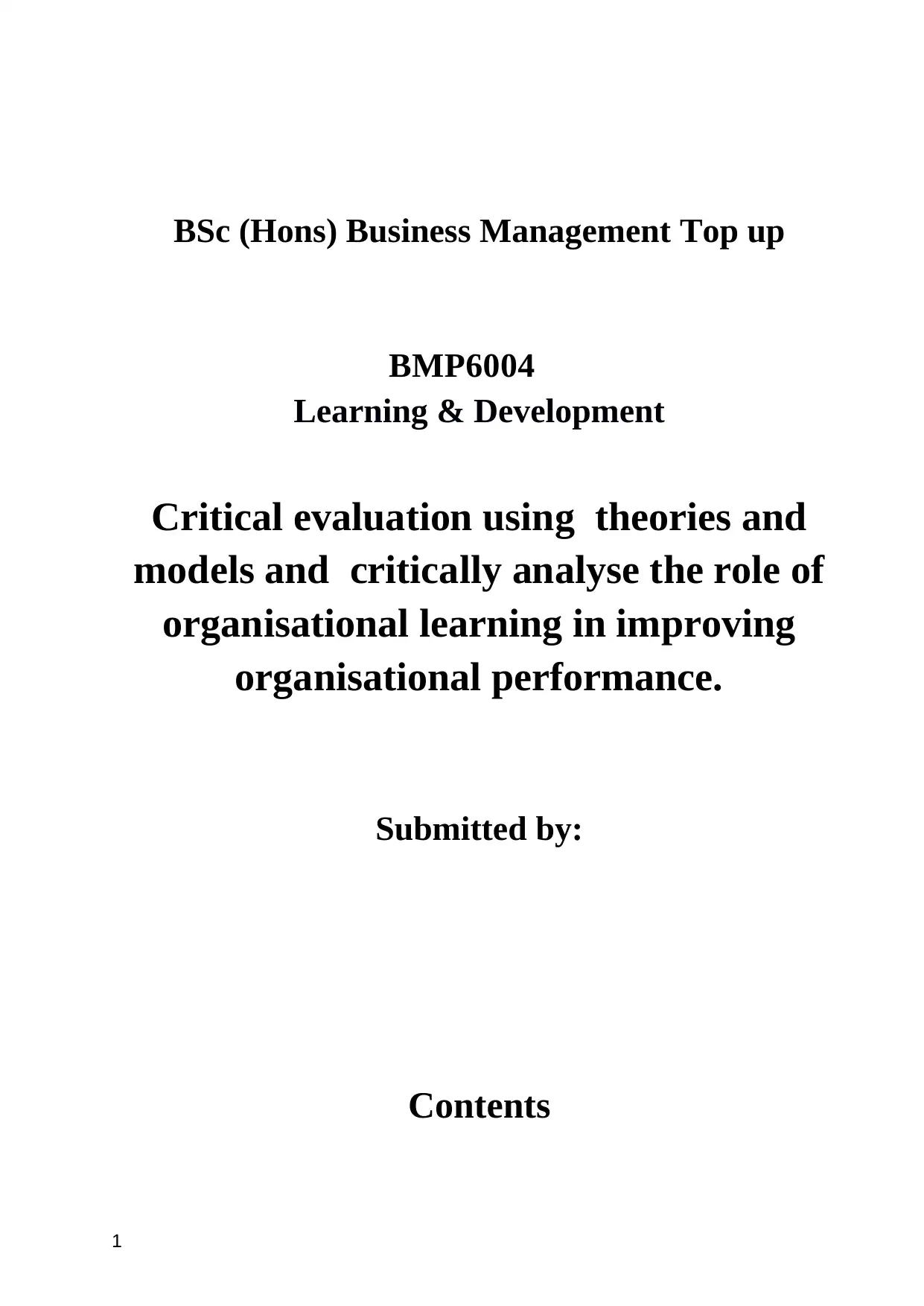
BSc (Hons) Business Management Top up
BMP6004
Learning & Development
Critical evaluation using theories and
models and critically analyse the role of
organisational learning in improving
organisational performance.
Submitted by:
Contents
1
BMP6004
Learning & Development
Critical evaluation using theories and
models and critically analyse the role of
organisational learning in improving
organisational performance.
Submitted by:
Contents
1
Paraphrase This Document
Need a fresh take? Get an instant paraphrase of this document with our AI Paraphraser
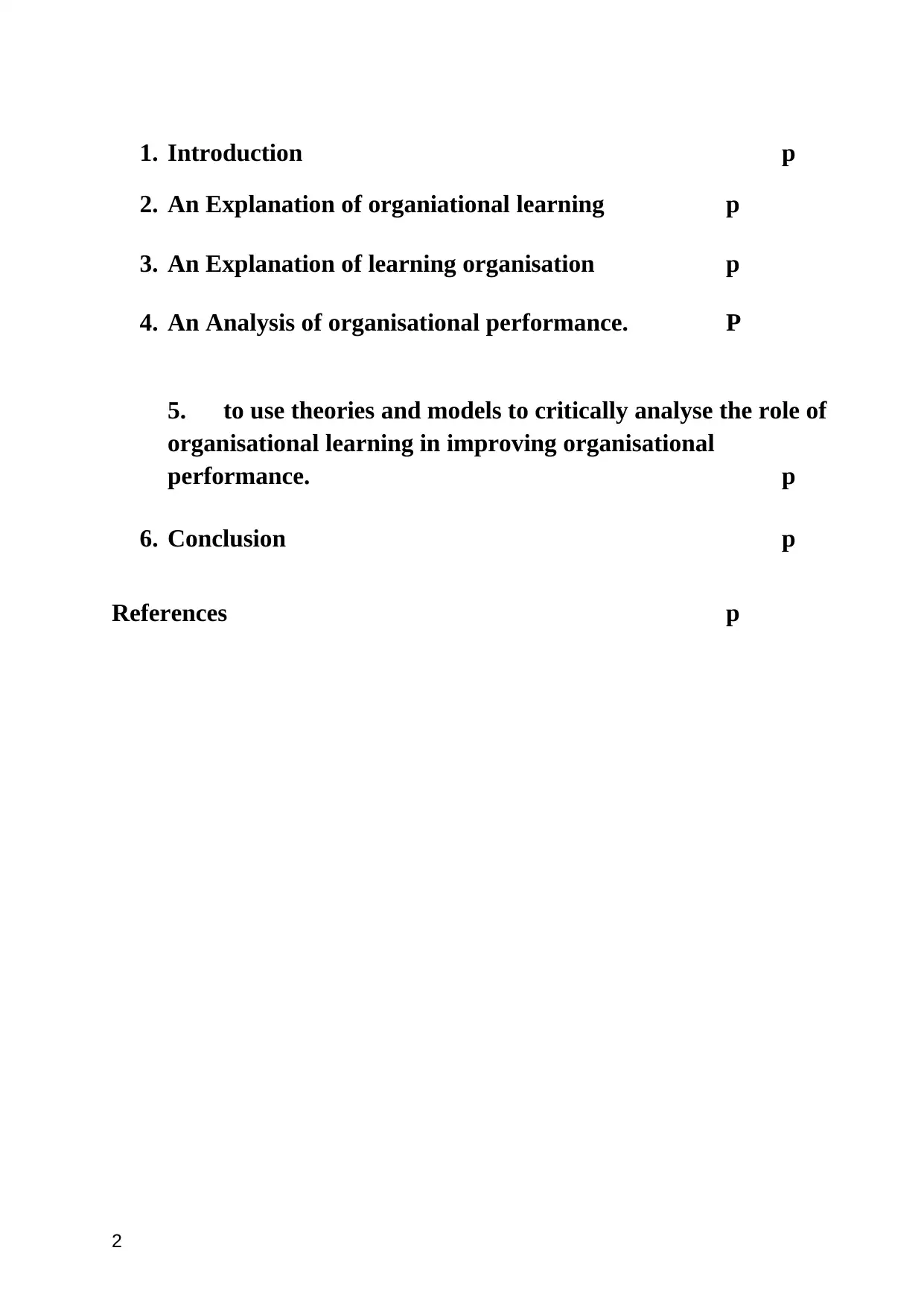
1. Introduction p
2. An Explanation of organiational learning p
3. An Explanation of learning organisation p
4. An Analysis of organisational performance. P
5. to use theories and models to critically analyse the role of
organisational learning in improving organisational
performance. p
6. Conclusion p
References p
2
2. An Explanation of organiational learning p
3. An Explanation of learning organisation p
4. An Analysis of organisational performance. P
5. to use theories and models to critically analyse the role of
organisational learning in improving organisational
performance. p
6. Conclusion p
References p
2
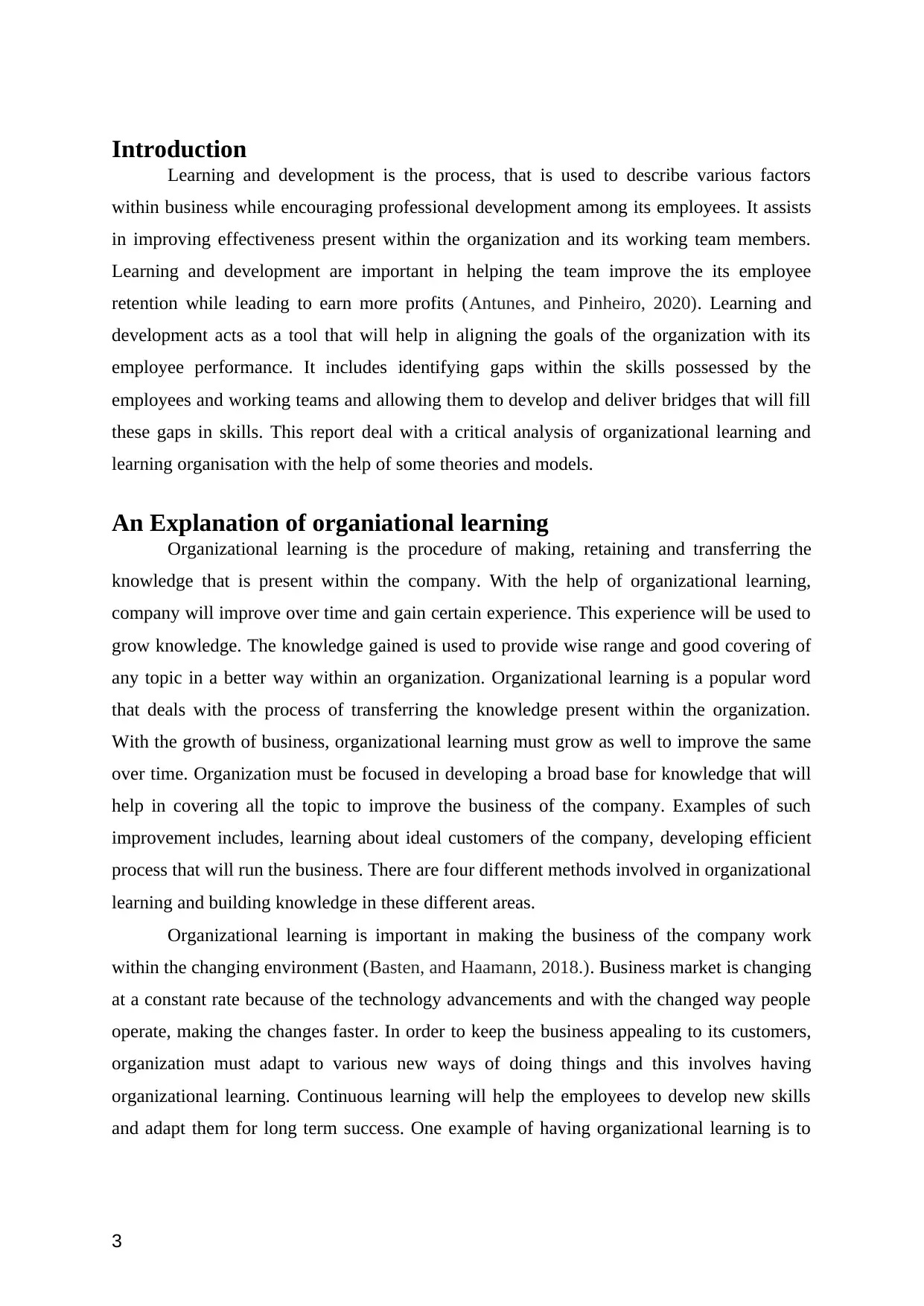
Introduction
Learning and development is the process, that is used to describe various factors
within business while encouraging professional development among its employees. It assists
in improving effectiveness present within the organization and its working team members.
Learning and development are important in helping the team improve the its employee
retention while leading to earn more profits (Antunes, and Pinheiro, 2020). Learning and
development acts as a tool that will help in aligning the goals of the organization with its
employee performance. It includes identifying gaps within the skills possessed by the
employees and working teams and allowing them to develop and deliver bridges that will fill
these gaps in skills. This report deal with a critical analysis of organizational learning and
learning organisation with the help of some theories and models.
An Explanation of organiational learning
Organizational learning is the procedure of making, retaining and transferring the
knowledge that is present within the company. With the help of organizational learning,
company will improve over time and gain certain experience. This experience will be used to
grow knowledge. The knowledge gained is used to provide wise range and good covering of
any topic in a better way within an organization. Organizational learning is a popular word
that deals with the process of transferring the knowledge present within the organization.
With the growth of business, organizational learning must grow as well to improve the same
over time. Organization must be focused in developing a broad base for knowledge that will
help in covering all the topic to improve the business of the company. Examples of such
improvement includes, learning about ideal customers of the company, developing efficient
process that will run the business. There are four different methods involved in organizational
learning and building knowledge in these different areas.
Organizational learning is important in making the business of the company work
within the changing environment (Basten, and Haamann, 2018.). Business market is changing
at a constant rate because of the technology advancements and with the changed way people
operate, making the changes faster. In order to keep the business appealing to its customers,
organization must adapt to various new ways of doing things and this involves having
organizational learning. Continuous learning will help the employees to develop new skills
and adapt them for long term success. One example of having organizational learning is to
3
Learning and development is the process, that is used to describe various factors
within business while encouraging professional development among its employees. It assists
in improving effectiveness present within the organization and its working team members.
Learning and development are important in helping the team improve the its employee
retention while leading to earn more profits (Antunes, and Pinheiro, 2020). Learning and
development acts as a tool that will help in aligning the goals of the organization with its
employee performance. It includes identifying gaps within the skills possessed by the
employees and working teams and allowing them to develop and deliver bridges that will fill
these gaps in skills. This report deal with a critical analysis of organizational learning and
learning organisation with the help of some theories and models.
An Explanation of organiational learning
Organizational learning is the procedure of making, retaining and transferring the
knowledge that is present within the company. With the help of organizational learning,
company will improve over time and gain certain experience. This experience will be used to
grow knowledge. The knowledge gained is used to provide wise range and good covering of
any topic in a better way within an organization. Organizational learning is a popular word
that deals with the process of transferring the knowledge present within the organization.
With the growth of business, organizational learning must grow as well to improve the same
over time. Organization must be focused in developing a broad base for knowledge that will
help in covering all the topic to improve the business of the company. Examples of such
improvement includes, learning about ideal customers of the company, developing efficient
process that will run the business. There are four different methods involved in organizational
learning and building knowledge in these different areas.
Organizational learning is important in making the business of the company work
within the changing environment (Basten, and Haamann, 2018.). Business market is changing
at a constant rate because of the technology advancements and with the changed way people
operate, making the changes faster. In order to keep the business appealing to its customers,
organization must adapt to various new ways of doing things and this involves having
organizational learning. Continuous learning will help the employees to develop new skills
and adapt them for long term success. One example of having organizational learning is to
3
⊘ This is a preview!⊘
Do you want full access?
Subscribe today to unlock all pages.

Trusted by 1+ million students worldwide
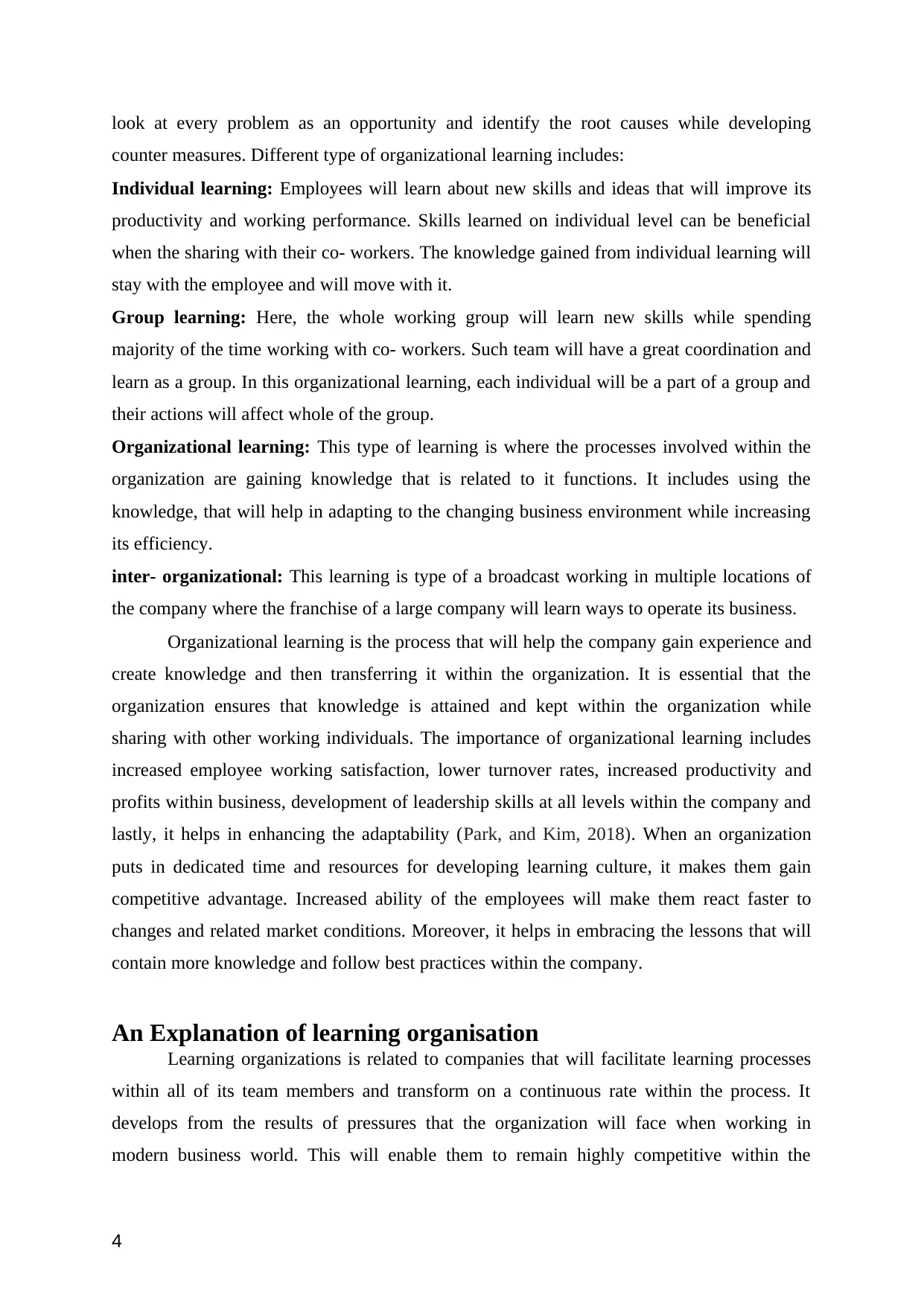
look at every problem as an opportunity and identify the root causes while developing
counter measures. Different type of organizational learning includes:
Individual learning: Employees will learn about new skills and ideas that will improve its
productivity and working performance. Skills learned on individual level can be beneficial
when the sharing with their co- workers. The knowledge gained from individual learning will
stay with the employee and will move with it.
Group learning: Here, the whole working group will learn new skills while spending
majority of the time working with co- workers. Such team will have a great coordination and
learn as a group. In this organizational learning, each individual will be a part of a group and
their actions will affect whole of the group.
Organizational learning: This type of learning is where the processes involved within the
organization are gaining knowledge that is related to it functions. It includes using the
knowledge, that will help in adapting to the changing business environment while increasing
its efficiency.
inter- organizational: This learning is type of a broadcast working in multiple locations of
the company where the franchise of a large company will learn ways to operate its business.
Organizational learning is the process that will help the company gain experience and
create knowledge and then transferring it within the organization. It is essential that the
organization ensures that knowledge is attained and kept within the organization while
sharing with other working individuals. The importance of organizational learning includes
increased employee working satisfaction, lower turnover rates, increased productivity and
profits within business, development of leadership skills at all levels within the company and
lastly, it helps in enhancing the adaptability (Park, and Kim, 2018). When an organization
puts in dedicated time and resources for developing learning culture, it makes them gain
competitive advantage. Increased ability of the employees will make them react faster to
changes and related market conditions. Moreover, it helps in embracing the lessons that will
contain more knowledge and follow best practices within the company.
An Explanation of learning organisation
Learning organizations is related to companies that will facilitate learning processes
within all of its team members and transform on a continuous rate within the process. It
develops from the results of pressures that the organization will face when working in
modern business world. This will enable them to remain highly competitive within the
4
counter measures. Different type of organizational learning includes:
Individual learning: Employees will learn about new skills and ideas that will improve its
productivity and working performance. Skills learned on individual level can be beneficial
when the sharing with their co- workers. The knowledge gained from individual learning will
stay with the employee and will move with it.
Group learning: Here, the whole working group will learn new skills while spending
majority of the time working with co- workers. Such team will have a great coordination and
learn as a group. In this organizational learning, each individual will be a part of a group and
their actions will affect whole of the group.
Organizational learning: This type of learning is where the processes involved within the
organization are gaining knowledge that is related to it functions. It includes using the
knowledge, that will help in adapting to the changing business environment while increasing
its efficiency.
inter- organizational: This learning is type of a broadcast working in multiple locations of
the company where the franchise of a large company will learn ways to operate its business.
Organizational learning is the process that will help the company gain experience and
create knowledge and then transferring it within the organization. It is essential that the
organization ensures that knowledge is attained and kept within the organization while
sharing with other working individuals. The importance of organizational learning includes
increased employee working satisfaction, lower turnover rates, increased productivity and
profits within business, development of leadership skills at all levels within the company and
lastly, it helps in enhancing the adaptability (Park, and Kim, 2018). When an organization
puts in dedicated time and resources for developing learning culture, it makes them gain
competitive advantage. Increased ability of the employees will make them react faster to
changes and related market conditions. Moreover, it helps in embracing the lessons that will
contain more knowledge and follow best practices within the company.
An Explanation of learning organisation
Learning organizations is related to companies that will facilitate learning processes
within all of its team members and transform on a continuous rate within the process. It
develops from the results of pressures that the organization will face when working in
modern business world. This will enable them to remain highly competitive within the
4
Paraphrase This Document
Need a fresh take? Get an instant paraphrase of this document with our AI Paraphraser
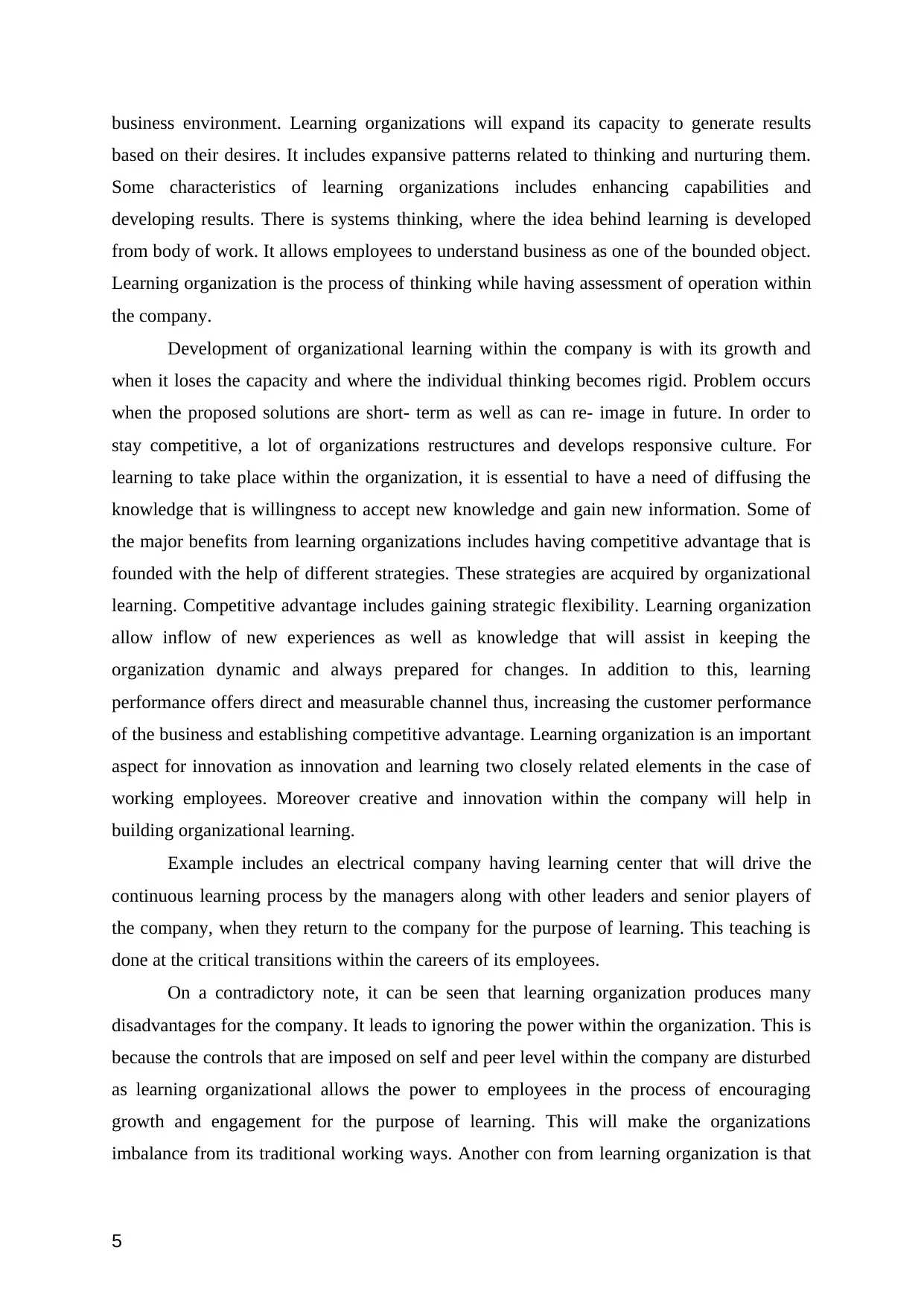
business environment. Learning organizations will expand its capacity to generate results
based on their desires. It includes expansive patterns related to thinking and nurturing them.
Some characteristics of learning organizations includes enhancing capabilities and
developing results. There is systems thinking, where the idea behind learning is developed
from body of work. It allows employees to understand business as one of the bounded object.
Learning organization is the process of thinking while having assessment of operation within
the company.
Development of organizational learning within the company is with its growth and
when it loses the capacity and where the individual thinking becomes rigid. Problem occurs
when the proposed solutions are short- term as well as can re- image in future. In order to
stay competitive, a lot of organizations restructures and develops responsive culture. For
learning to take place within the organization, it is essential to have a need of diffusing the
knowledge that is willingness to accept new knowledge and gain new information. Some of
the major benefits from learning organizations includes having competitive advantage that is
founded with the help of different strategies. These strategies are acquired by organizational
learning. Competitive advantage includes gaining strategic flexibility. Learning organization
allow inflow of new experiences as well as knowledge that will assist in keeping the
organization dynamic and always prepared for changes. In addition to this, learning
performance offers direct and measurable channel thus, increasing the customer performance
of the business and establishing competitive advantage. Learning organization is an important
aspect for innovation as innovation and learning two closely related elements in the case of
working employees. Moreover creative and innovation within the company will help in
building organizational learning.
Example includes an electrical company having learning center that will drive the
continuous learning process by the managers along with other leaders and senior players of
the company, when they return to the company for the purpose of learning. This teaching is
done at the critical transitions within the careers of its employees.
On a contradictory note, it can be seen that learning organization produces many
disadvantages for the company. It leads to ignoring the power within the organization. This is
because the controls that are imposed on self and peer level within the company are disturbed
as learning organizational allows the power to employees in the process of encouraging
growth and engagement for the purpose of learning. This will make the organizations
imbalance from its traditional working ways. Another con from learning organization is that
5
based on their desires. It includes expansive patterns related to thinking and nurturing them.
Some characteristics of learning organizations includes enhancing capabilities and
developing results. There is systems thinking, where the idea behind learning is developed
from body of work. It allows employees to understand business as one of the bounded object.
Learning organization is the process of thinking while having assessment of operation within
the company.
Development of organizational learning within the company is with its growth and
when it loses the capacity and where the individual thinking becomes rigid. Problem occurs
when the proposed solutions are short- term as well as can re- image in future. In order to
stay competitive, a lot of organizations restructures and develops responsive culture. For
learning to take place within the organization, it is essential to have a need of diffusing the
knowledge that is willingness to accept new knowledge and gain new information. Some of
the major benefits from learning organizations includes having competitive advantage that is
founded with the help of different strategies. These strategies are acquired by organizational
learning. Competitive advantage includes gaining strategic flexibility. Learning organization
allow inflow of new experiences as well as knowledge that will assist in keeping the
organization dynamic and always prepared for changes. In addition to this, learning
performance offers direct and measurable channel thus, increasing the customer performance
of the business and establishing competitive advantage. Learning organization is an important
aspect for innovation as innovation and learning two closely related elements in the case of
working employees. Moreover creative and innovation within the company will help in
building organizational learning.
Example includes an electrical company having learning center that will drive the
continuous learning process by the managers along with other leaders and senior players of
the company, when they return to the company for the purpose of learning. This teaching is
done at the critical transitions within the careers of its employees.
On a contradictory note, it can be seen that learning organization produces many
disadvantages for the company. It leads to ignoring the power within the organization. This is
because the controls that are imposed on self and peer level within the company are disturbed
as learning organizational allows the power to employees in the process of encouraging
growth and engagement for the purpose of learning. This will make the organizations
imbalance from its traditional working ways. Another con from learning organization is that
5
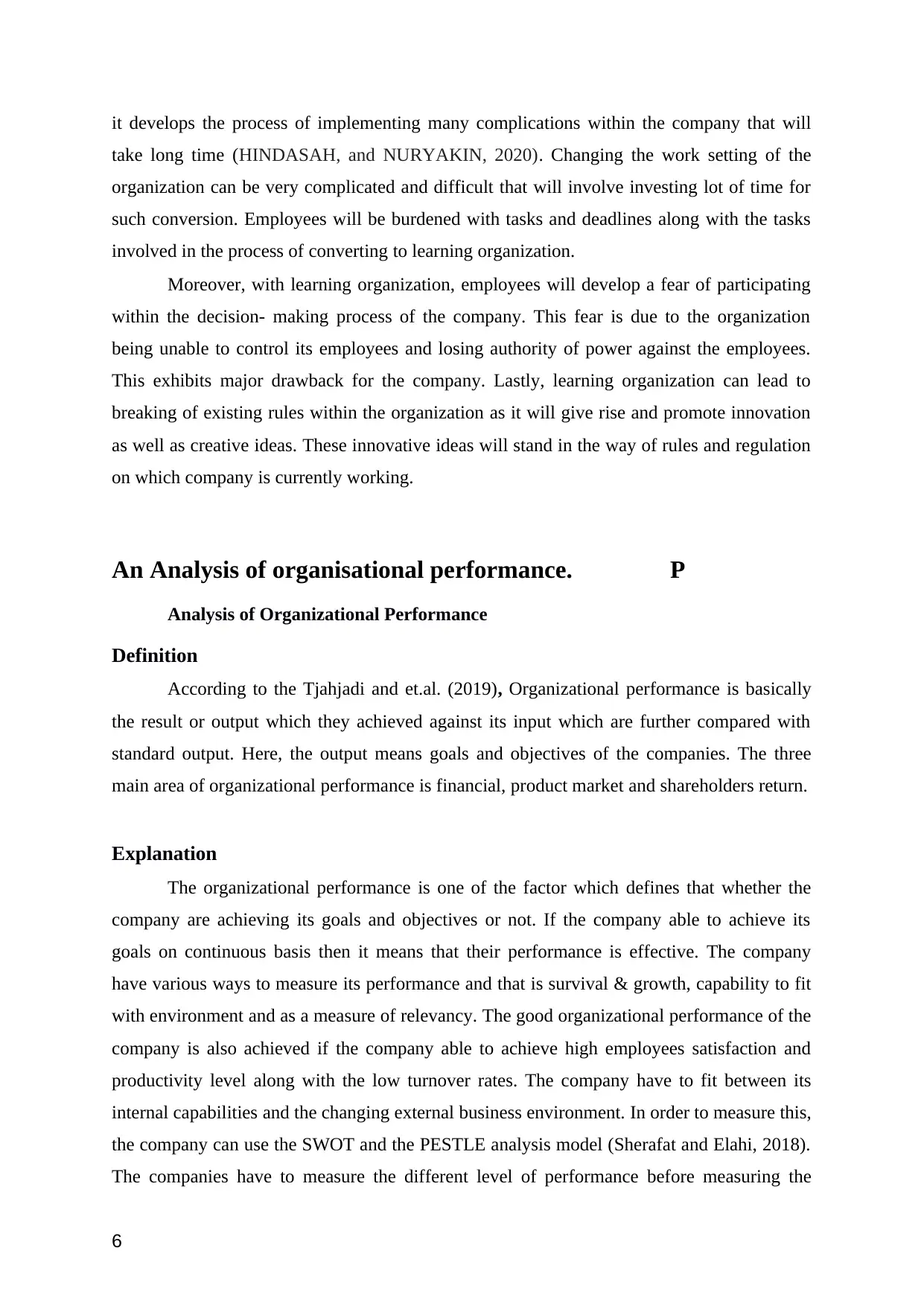
it develops the process of implementing many complications within the company that will
take long time (HINDASAH, and NURYAKIN, 2020). Changing the work setting of the
organization can be very complicated and difficult that will involve investing lot of time for
such conversion. Employees will be burdened with tasks and deadlines along with the tasks
involved in the process of converting to learning organization.
Moreover, with learning organization, employees will develop a fear of participating
within the decision- making process of the company. This fear is due to the organization
being unable to control its employees and losing authority of power against the employees.
This exhibits major drawback for the company. Lastly, learning organization can lead to
breaking of existing rules within the organization as it will give rise and promote innovation
as well as creative ideas. These innovative ideas will stand in the way of rules and regulation
on which company is currently working.
An Analysis of organisational performance. P
Analysis of Organizational Performance
Definition
According to the Tjahjadi and et.al. (2019), Organizational performance is basically
the result or output which they achieved against its input which are further compared with
standard output. Here, the output means goals and objectives of the companies. The three
main area of organizational performance is financial, product market and shareholders return.
Explanation
The organizational performance is one of the factor which defines that whether the
company are achieving its goals and objectives or not. If the company able to achieve its
goals on continuous basis then it means that their performance is effective. The company
have various ways to measure its performance and that is survival & growth, capability to fit
with environment and as a measure of relevancy. The good organizational performance of the
company is also achieved if the company able to achieve high employees satisfaction and
productivity level along with the low turnover rates. The company have to fit between its
internal capabilities and the changing external business environment. In order to measure this,
the company can use the SWOT and the PESTLE analysis model (Sherafat and Elahi, 2018).
The companies have to measure the different level of performance before measuring the
6
take long time (HINDASAH, and NURYAKIN, 2020). Changing the work setting of the
organization can be very complicated and difficult that will involve investing lot of time for
such conversion. Employees will be burdened with tasks and deadlines along with the tasks
involved in the process of converting to learning organization.
Moreover, with learning organization, employees will develop a fear of participating
within the decision- making process of the company. This fear is due to the organization
being unable to control its employees and losing authority of power against the employees.
This exhibits major drawback for the company. Lastly, learning organization can lead to
breaking of existing rules within the organization as it will give rise and promote innovation
as well as creative ideas. These innovative ideas will stand in the way of rules and regulation
on which company is currently working.
An Analysis of organisational performance. P
Analysis of Organizational Performance
Definition
According to the Tjahjadi and et.al. (2019), Organizational performance is basically
the result or output which they achieved against its input which are further compared with
standard output. Here, the output means goals and objectives of the companies. The three
main area of organizational performance is financial, product market and shareholders return.
Explanation
The organizational performance is one of the factor which defines that whether the
company are achieving its goals and objectives or not. If the company able to achieve its
goals on continuous basis then it means that their performance is effective. The company
have various ways to measure its performance and that is survival & growth, capability to fit
with environment and as a measure of relevancy. The good organizational performance of the
company is also achieved if the company able to achieve high employees satisfaction and
productivity level along with the low turnover rates. The company have to fit between its
internal capabilities and the changing external business environment. In order to measure this,
the company can use the SWOT and the PESTLE analysis model (Sherafat and Elahi, 2018).
The companies have to measure the different level of performance before measuring the
6
⊘ This is a preview!⊘
Do you want full access?
Subscribe today to unlock all pages.

Trusted by 1+ million students worldwide
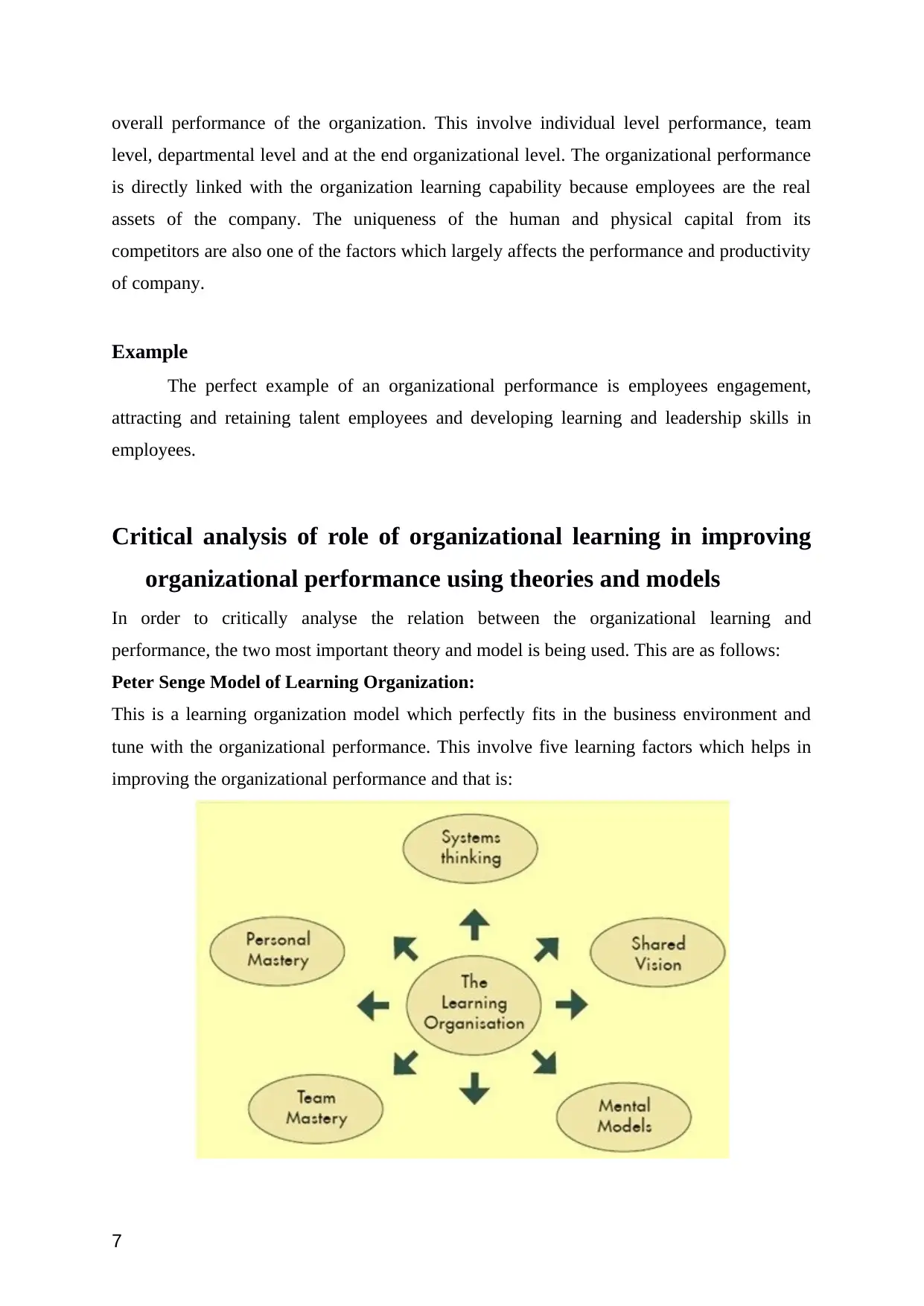
overall performance of the organization. This involve individual level performance, team
level, departmental level and at the end organizational level. The organizational performance
is directly linked with the organization learning capability because employees are the real
assets of the company. The uniqueness of the human and physical capital from its
competitors are also one of the factors which largely affects the performance and productivity
of company.
Example
The perfect example of an organizational performance is employees engagement,
attracting and retaining talent employees and developing learning and leadership skills in
employees.
Critical analysis of role of organizational learning in improving
organizational performance using theories and models
In order to critically analyse the relation between the organizational learning and
performance, the two most important theory and model is being used. This are as follows:
Peter Senge Model of Learning Organization:
This is a learning organization model which perfectly fits in the business environment and
tune with the organizational performance. This involve five learning factors which helps in
improving the organizational performance and that is:
7
level, departmental level and at the end organizational level. The organizational performance
is directly linked with the organization learning capability because employees are the real
assets of the company. The uniqueness of the human and physical capital from its
competitors are also one of the factors which largely affects the performance and productivity
of company.
Example
The perfect example of an organizational performance is employees engagement,
attracting and retaining talent employees and developing learning and leadership skills in
employees.
Critical analysis of role of organizational learning in improving
organizational performance using theories and models
In order to critically analyse the relation between the organizational learning and
performance, the two most important theory and model is being used. This are as follows:
Peter Senge Model of Learning Organization:
This is a learning organization model which perfectly fits in the business environment and
tune with the organizational performance. This involve five learning factors which helps in
improving the organizational performance and that is:
7
Paraphrase This Document
Need a fresh take? Get an instant paraphrase of this document with our AI Paraphraser
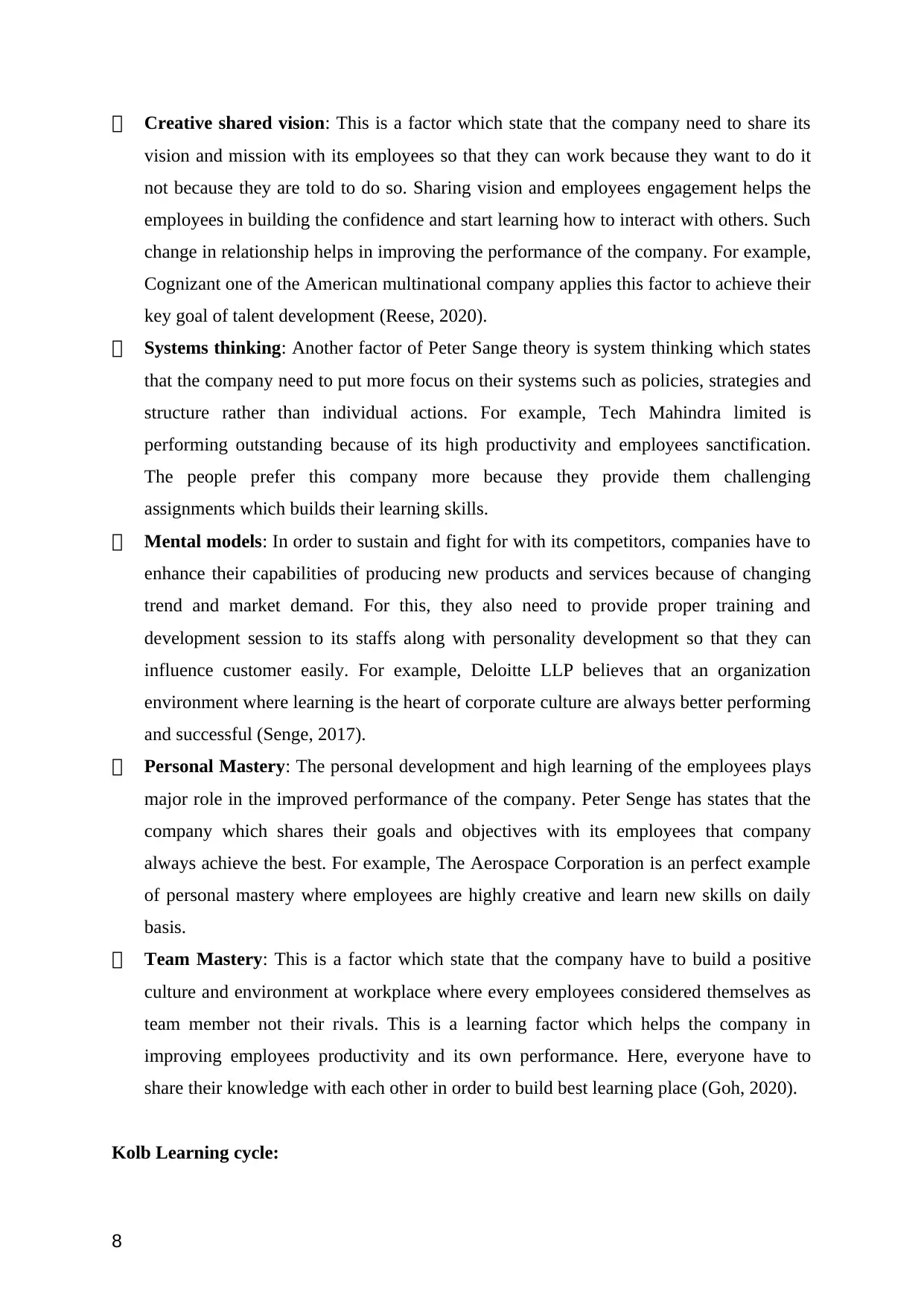
Creative shared vision: This is a factor which state that the company need to share its
vision and mission with its employees so that they can work because they want to do it
not because they are told to do so. Sharing vision and employees engagement helps the
employees in building the confidence and start learning how to interact with others. Such
change in relationship helps in improving the performance of the company. For example,
Cognizant one of the American multinational company applies this factor to achieve their
key goal of talent development (Reese, 2020).
Systems thinking: Another factor of Peter Sange theory is system thinking which states
that the company need to put more focus on their systems such as policies, strategies and
structure rather than individual actions. For example, Tech Mahindra limited is
performing outstanding because of its high productivity and employees sanctification.
The people prefer this company more because they provide them challenging
assignments which builds their learning skills.
Mental models: In order to sustain and fight for with its competitors, companies have to
enhance their capabilities of producing new products and services because of changing
trend and market demand. For this, they also need to provide proper training and
development session to its staffs along with personality development so that they can
influence customer easily. For example, Deloitte LLP believes that an organization
environment where learning is the heart of corporate culture are always better performing
and successful (Senge, 2017).
Personal Mastery: The personal development and high learning of the employees plays
major role in the improved performance of the company. Peter Senge has states that the
company which shares their goals and objectives with its employees that company
always achieve the best. For example, The Aerospace Corporation is an perfect example
of personal mastery where employees are highly creative and learn new skills on daily
basis.
Team Mastery: This is a factor which state that the company have to build a positive
culture and environment at workplace where every employees considered themselves as
team member not their rivals. This is a learning factor which helps the company in
improving employees productivity and its own performance. Here, everyone have to
share their knowledge with each other in order to build best learning place (Goh, 2020).
Kolb Learning cycle:
8
vision and mission with its employees so that they can work because they want to do it
not because they are told to do so. Sharing vision and employees engagement helps the
employees in building the confidence and start learning how to interact with others. Such
change in relationship helps in improving the performance of the company. For example,
Cognizant one of the American multinational company applies this factor to achieve their
key goal of talent development (Reese, 2020).
Systems thinking: Another factor of Peter Sange theory is system thinking which states
that the company need to put more focus on their systems such as policies, strategies and
structure rather than individual actions. For example, Tech Mahindra limited is
performing outstanding because of its high productivity and employees sanctification.
The people prefer this company more because they provide them challenging
assignments which builds their learning skills.
Mental models: In order to sustain and fight for with its competitors, companies have to
enhance their capabilities of producing new products and services because of changing
trend and market demand. For this, they also need to provide proper training and
development session to its staffs along with personality development so that they can
influence customer easily. For example, Deloitte LLP believes that an organization
environment where learning is the heart of corporate culture are always better performing
and successful (Senge, 2017).
Personal Mastery: The personal development and high learning of the employees plays
major role in the improved performance of the company. Peter Senge has states that the
company which shares their goals and objectives with its employees that company
always achieve the best. For example, The Aerospace Corporation is an perfect example
of personal mastery where employees are highly creative and learn new skills on daily
basis.
Team Mastery: This is a factor which state that the company have to build a positive
culture and environment at workplace where every employees considered themselves as
team member not their rivals. This is a learning factor which helps the company in
improving employees productivity and its own performance. Here, everyone have to
share their knowledge with each other in order to build best learning place (Goh, 2020).
Kolb Learning cycle:
8
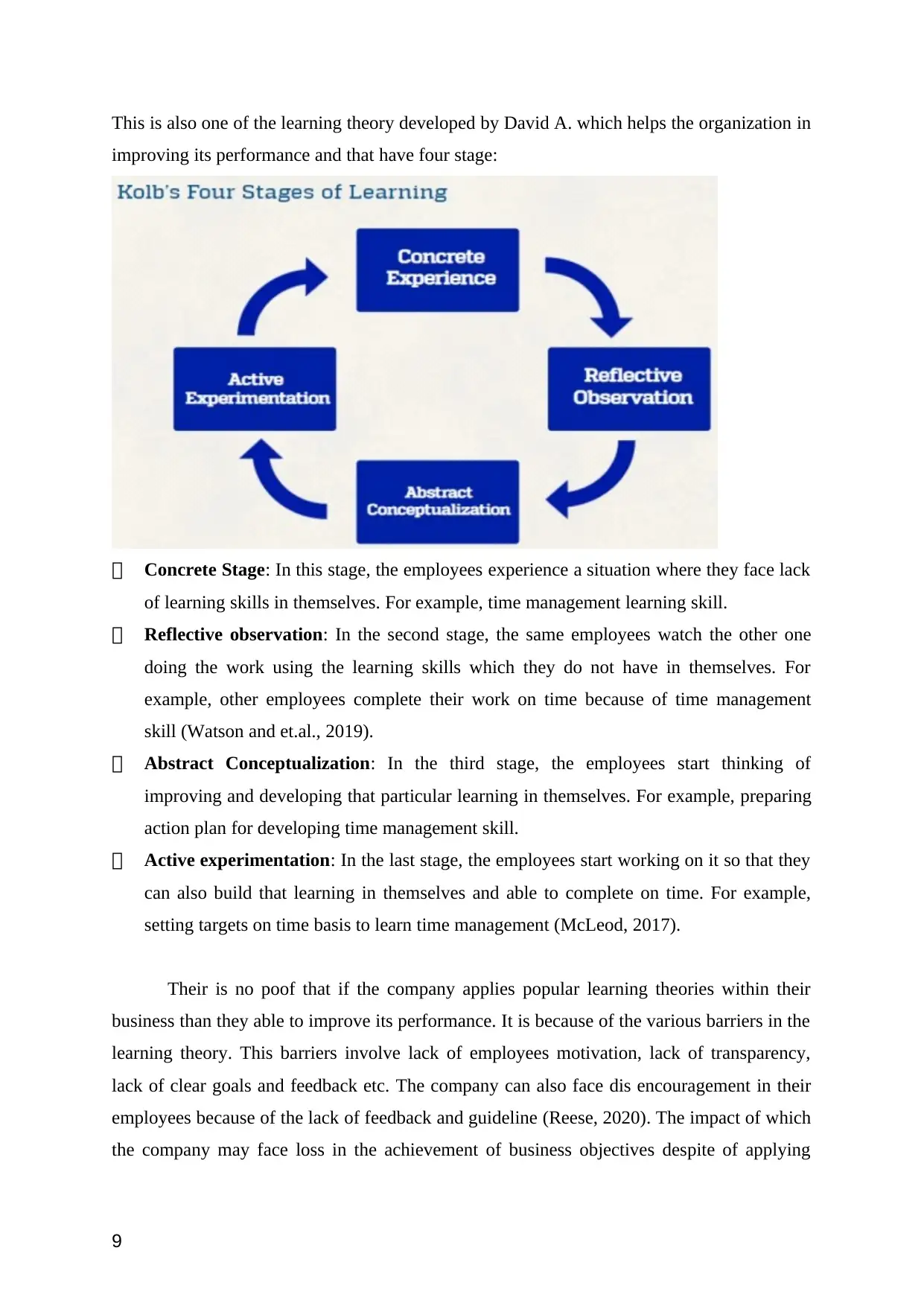
This is also one of the learning theory developed by David A. which helps the organization in
improving its performance and that have four stage:
Concrete Stage: In this stage, the employees experience a situation where they face lack
of learning skills in themselves. For example, time management learning skill.
Reflective observation: In the second stage, the same employees watch the other one
doing the work using the learning skills which they do not have in themselves. For
example, other employees complete their work on time because of time management
skill (Watson and et.al., 2019).
Abstract Conceptualization: In the third stage, the employees start thinking of
improving and developing that particular learning in themselves. For example, preparing
action plan for developing time management skill.
Active experimentation: In the last stage, the employees start working on it so that they
can also build that learning in themselves and able to complete on time. For example,
setting targets on time basis to learn time management (McLeod, 2017).
Their is no poof that if the company applies popular learning theories within their
business than they able to improve its performance. It is because of the various barriers in the
learning theory. This barriers involve lack of employees motivation, lack of transparency,
lack of clear goals and feedback etc. The company can also face dis encouragement in their
employees because of the lack of feedback and guideline (Reese, 2020). The impact of which
the company may face loss in the achievement of business objectives despite of applying
9
improving its performance and that have four stage:
Concrete Stage: In this stage, the employees experience a situation where they face lack
of learning skills in themselves. For example, time management learning skill.
Reflective observation: In the second stage, the same employees watch the other one
doing the work using the learning skills which they do not have in themselves. For
example, other employees complete their work on time because of time management
skill (Watson and et.al., 2019).
Abstract Conceptualization: In the third stage, the employees start thinking of
improving and developing that particular learning in themselves. For example, preparing
action plan for developing time management skill.
Active experimentation: In the last stage, the employees start working on it so that they
can also build that learning in themselves and able to complete on time. For example,
setting targets on time basis to learn time management (McLeod, 2017).
Their is no poof that if the company applies popular learning theories within their
business than they able to improve its performance. It is because of the various barriers in the
learning theory. This barriers involve lack of employees motivation, lack of transparency,
lack of clear goals and feedback etc. The company can also face dis encouragement in their
employees because of the lack of feedback and guideline (Reese, 2020). The impact of which
the company may face loss in the achievement of business objectives despite of applying
9
⊘ This is a preview!⊘
Do you want full access?
Subscribe today to unlock all pages.

Trusted by 1+ million students worldwide
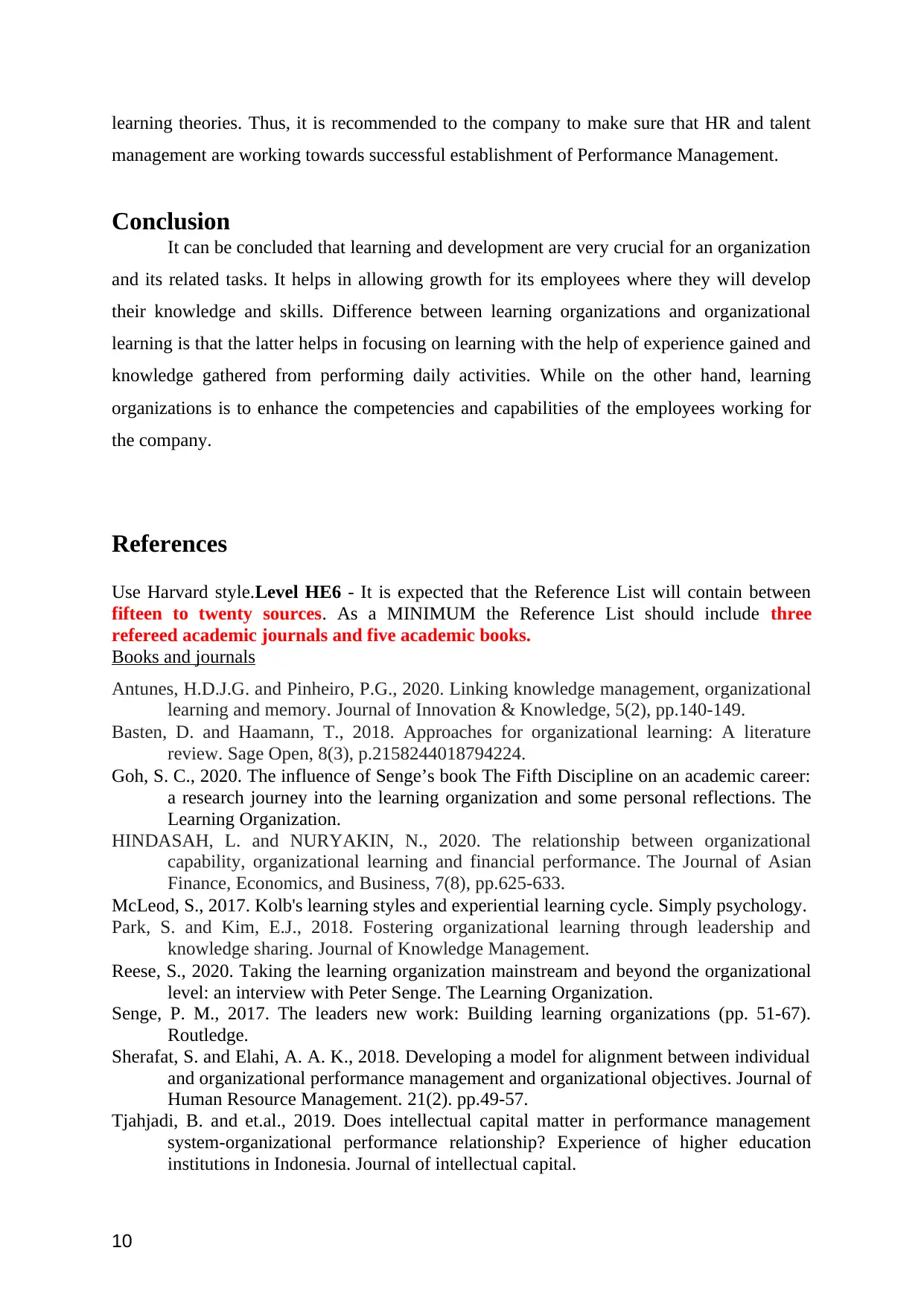
learning theories. Thus, it is recommended to the company to make sure that HR and talent
management are working towards successful establishment of Performance Management.
Conclusion
It can be concluded that learning and development are very crucial for an organization
and its related tasks. It helps in allowing growth for its employees where they will develop
their knowledge and skills. Difference between learning organizations and organizational
learning is that the latter helps in focusing on learning with the help of experience gained and
knowledge gathered from performing daily activities. While on the other hand, learning
organizations is to enhance the competencies and capabilities of the employees working for
the company.
References
Use Harvard style.Level HE6 - It is expected that the Reference List will contain between
fifteen to twenty sources. As a MINIMUM the Reference List should include three
refereed academic journals and five academic books.
Books and journals
Antunes, H.D.J.G. and Pinheiro, P.G., 2020. Linking knowledge management, organizational
learning and memory. Journal of Innovation & Knowledge, 5(2), pp.140-149.
Basten, D. and Haamann, T., 2018. Approaches for organizational learning: A literature
review. Sage Open, 8(3), p.2158244018794224.
Goh, S. C., 2020. The influence of Senge’s book The Fifth Discipline on an academic career:
a research journey into the learning organization and some personal reflections. The
Learning Organization.
HINDASAH, L. and NURYAKIN, N., 2020. The relationship between organizational
capability, organizational learning and financial performance. The Journal of Asian
Finance, Economics, and Business, 7(8), pp.625-633.
McLeod, S., 2017. Kolb's learning styles and experiential learning cycle. Simply psychology.
Park, S. and Kim, E.J., 2018. Fostering organizational learning through leadership and
knowledge sharing. Journal of Knowledge Management.
Reese, S., 2020. Taking the learning organization mainstream and beyond the organizational
level: an interview with Peter Senge. The Learning Organization.
Senge, P. M., 2017. The leaders new work: Building learning organizations (pp. 51-67).
Routledge.
Sherafat, S. and Elahi, A. A. K., 2018. Developing a model for alignment between individual
and organizational performance management and organizational objectives. Journal of
Human Resource Management. 21(2). pp.49-57.
Tjahjadi, B. and et.al., 2019. Does intellectual capital matter in performance management
system-organizational performance relationship? Experience of higher education
institutions in Indonesia. Journal of intellectual capital.
10
management are working towards successful establishment of Performance Management.
Conclusion
It can be concluded that learning and development are very crucial for an organization
and its related tasks. It helps in allowing growth for its employees where they will develop
their knowledge and skills. Difference between learning organizations and organizational
learning is that the latter helps in focusing on learning with the help of experience gained and
knowledge gathered from performing daily activities. While on the other hand, learning
organizations is to enhance the competencies and capabilities of the employees working for
the company.
References
Use Harvard style.Level HE6 - It is expected that the Reference List will contain between
fifteen to twenty sources. As a MINIMUM the Reference List should include three
refereed academic journals and five academic books.
Books and journals
Antunes, H.D.J.G. and Pinheiro, P.G., 2020. Linking knowledge management, organizational
learning and memory. Journal of Innovation & Knowledge, 5(2), pp.140-149.
Basten, D. and Haamann, T., 2018. Approaches for organizational learning: A literature
review. Sage Open, 8(3), p.2158244018794224.
Goh, S. C., 2020. The influence of Senge’s book The Fifth Discipline on an academic career:
a research journey into the learning organization and some personal reflections. The
Learning Organization.
HINDASAH, L. and NURYAKIN, N., 2020. The relationship between organizational
capability, organizational learning and financial performance. The Journal of Asian
Finance, Economics, and Business, 7(8), pp.625-633.
McLeod, S., 2017. Kolb's learning styles and experiential learning cycle. Simply psychology.
Park, S. and Kim, E.J., 2018. Fostering organizational learning through leadership and
knowledge sharing. Journal of Knowledge Management.
Reese, S., 2020. Taking the learning organization mainstream and beyond the organizational
level: an interview with Peter Senge. The Learning Organization.
Senge, P. M., 2017. The leaders new work: Building learning organizations (pp. 51-67).
Routledge.
Sherafat, S. and Elahi, A. A. K., 2018. Developing a model for alignment between individual
and organizational performance management and organizational objectives. Journal of
Human Resource Management. 21(2). pp.49-57.
Tjahjadi, B. and et.al., 2019. Does intellectual capital matter in performance management
system-organizational performance relationship? Experience of higher education
institutions in Indonesia. Journal of intellectual capital.
10
Paraphrase This Document
Need a fresh take? Get an instant paraphrase of this document with our AI Paraphraser
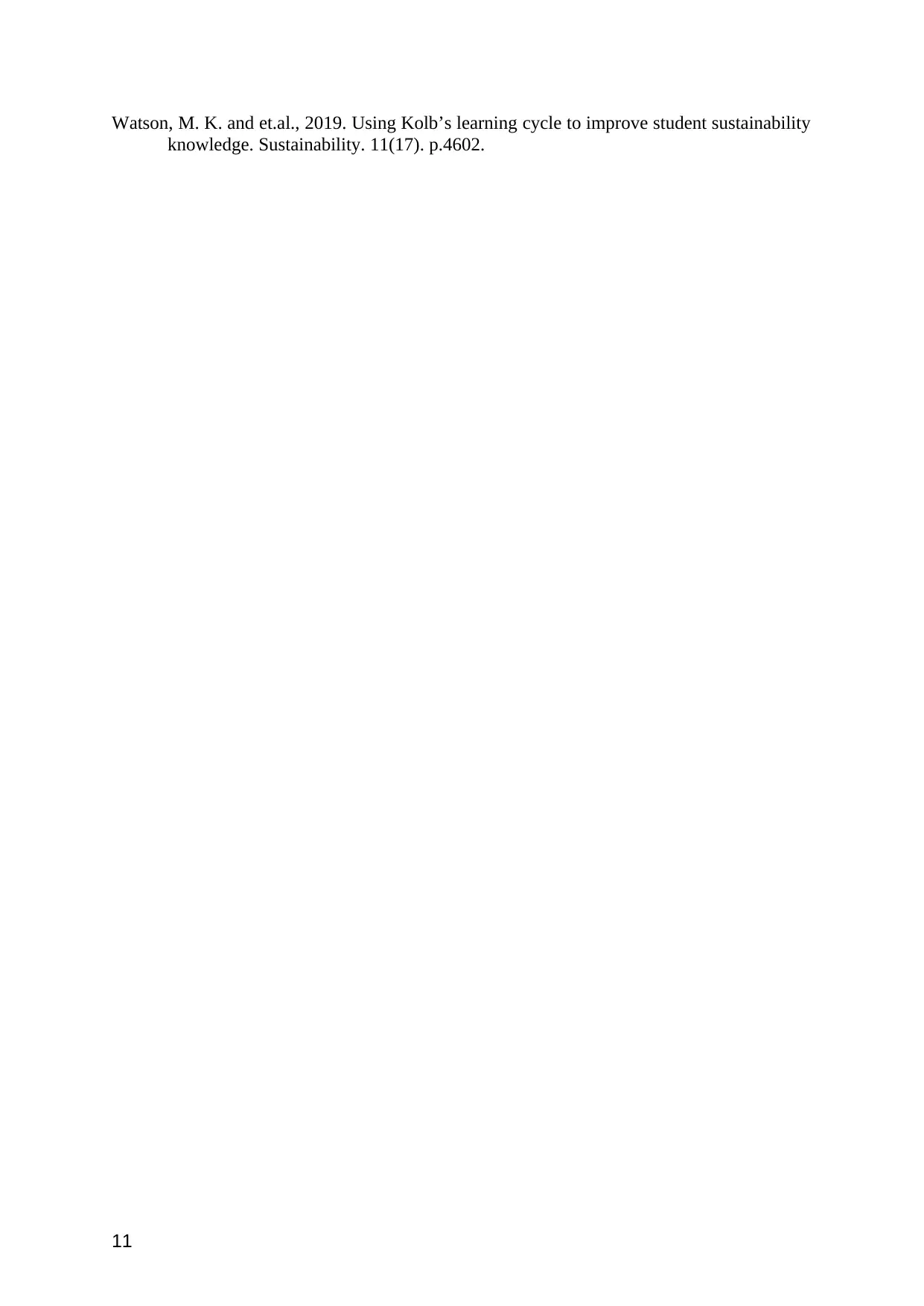
Watson, M. K. and et.al., 2019. Using Kolb’s learning cycle to improve student sustainability
knowledge. Sustainability. 11(17). p.4602.
11
knowledge. Sustainability. 11(17). p.4602.
11
1 out of 11
Related Documents
Your All-in-One AI-Powered Toolkit for Academic Success.
+13062052269
info@desklib.com
Available 24*7 on WhatsApp / Email
![[object Object]](/_next/static/media/star-bottom.7253800d.svg)
Unlock your academic potential
Copyright © 2020–2025 A2Z Services. All Rights Reserved. Developed and managed by ZUCOL.


